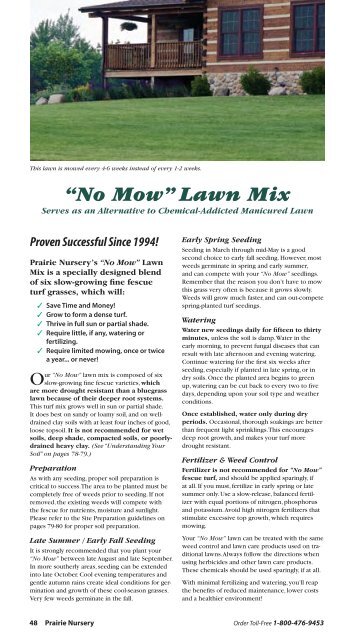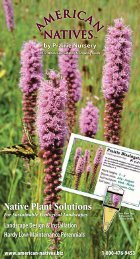Native Plant & Seed Solutions - Prairie Nursery
Native Plant & Seed Solutions - Prairie Nursery
Native Plant & Seed Solutions - Prairie Nursery
You also want an ePaper? Increase the reach of your titles
YUMPU automatically turns print PDFs into web optimized ePapers that Google loves.
This lawn is mowed every 4-6 weeks instead of every 1-2 weeks.<br />
“No Mow” Lawn Mix<br />
Serves as an Alternative to Chemical-Addicted Manicured Lawn<br />
Proven Successful Since 1994!<br />
<strong>Prairie</strong> <strong>Nursery</strong>’s “No Mow” Lawn<br />
Mix is a specially designed blend<br />
of six slow-growing fine fescue<br />
turf grasses, which will:<br />
3 Save Time and Money!<br />
3 Grow to form a dense turf.<br />
3 Thrive in full sun or partial shade.<br />
3 Require little, if any, watering or<br />
fertilizing.<br />
3 Require limited mowing, once or twice<br />
a year... or never!<br />
Our “No Mow” lawn mix is composed of six<br />
slow-growing fine fescue varieties, which<br />
are more drought resistant than a bluegrass<br />
lawn because of their deeper root systems.<br />
This turf mix grows well in sun or partial shade.<br />
It does best on sandy or loamy soil, and on welldrained<br />
clay soils with at least four inches of good,<br />
loose topsoil. It is not recommended for wet<br />
soils, deep shade, compacted soils, or poorlydrained<br />
heavy clay. (See “Understanding Your<br />
Soil” on pages 78-79.)<br />
Preparation<br />
As with any seeding, proper soil preparation is<br />
critical to success. The area to be planted must be<br />
completely free of weeds prior to seeding. If not<br />
removed, the existing weeds will compete with<br />
the fescue for nutrients, moisture and sunlight.<br />
Please refer to the Site Preparation guidelines on<br />
pages 79-80 for proper soil preparation.<br />
Late Summer / Early Fall <strong>Seed</strong>ing<br />
It is strongly recommended that you plant your<br />
“No Mow” between late August and late September.<br />
In more southerly areas, seeding can be extended<br />
into late October. Cool evening temperatures and<br />
gentle autumn rains create ideal conditions for germination<br />
and growth of these cool-season grasses.<br />
Very few weeds germinate in the fall.<br />
Early Spring <strong>Seed</strong>ing<br />
<strong>Seed</strong>ing in March through mid-May is a good<br />
second choice to early fall seeding. However, most<br />
weeds germinate in spring and early summer,<br />
and can compete with your “No Mow” seedlings.<br />
Remember that the reason you don’t have to mow<br />
this grass very often is because it grows slowly.<br />
Weeds will grow much faster, and can out-compete<br />
spring-planted turf seedings.<br />
Watering<br />
Water new seedings daily for fifteen to thirty<br />
minutes, unless the soil is damp. Water in the<br />
early morning, to prevent fungal diseases that can<br />
result with late afternoon and evening watering.<br />
Continue watering for the first six weeks after<br />
seeding, especially if planted in late spring, or in<br />
dry soils. Once the planted area begins to green<br />
up, watering can be cut back to every two to five<br />
days, depending upon your soil type and weather<br />
conditions.<br />
Once established, water only during dry<br />
periods. Occasional, thorough soakings are better<br />
than frequent light sprinklings. This encourages<br />
deep root growth, and makes your turf more<br />
drought resistant.<br />
Fertilizer & Weed Control<br />
Fertilizer is not recommended for “No Mow”<br />
fescue turf, and should be applied sparingly, if<br />
at all. If you must, fertilize in early spring or late<br />
summer only. Use a slow-release, balanced fertilizer<br />
with equal portions of nitrogen, phosphorus<br />
and potassium. Avoid high nitrogen fertilizers that<br />
stimulate excessive top growth, which requires<br />
mowing.<br />
Your “No Mow” lawn can be treated with the same<br />
weed control and lawn care products used on traditional<br />
lawns. Always follow the directions when<br />
using herbicides and other lawn care products.<br />
These chemicals should be used sparingly, if at all.<br />
With minimal fertilizing and watering, you’ll reap<br />
the benefits of reduced maintenance, lower costs<br />
and a healthier environment!<br />
48 <strong>Prairie</strong> <strong>Nursery</strong> Order Toll-Free 1-800-476-9453



